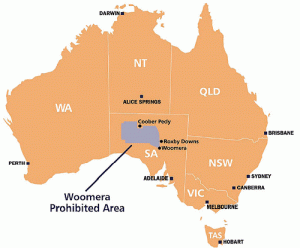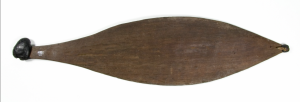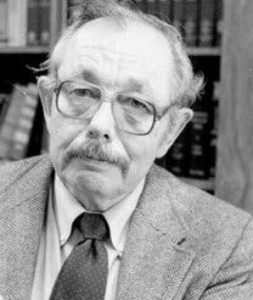The Woomera Range Complex located in the northwest region of southern Australia was a hub of space and defense testing and development for the nation of Australia beginning in the late 1940s. The Complex, consisting of the Woomera Prohibited area and the Woomera Restricted Airspace, remains an area of defense related development for the Australian government, and serves as a location for weapons testing, the mining and development of explosive and hazardous materials, and special forces preparation (Royal Australian Air Force). However, the range itself was the location of significant human development before it was utilized by the commonwealth. The range served as a home for countless Indigenous Australian people of different groups, and contains sites of significance to many that still exist in Australia to this day. The history of the Woomera range goes back thousands of years, and the presence of Indigenous Australians on its grounds cannot be ignored.
The land of the Woomera Protected area includes the lands of six Indigenous Australian groups. A majority of this land (30%) belonged to the Maralinga Tjarutja and the Anangu Pitjantjatjara Yunkunytjatjara, and the remainder was spread between the Antakirinja Matu-Yankunytjatjara, Arabana, Gawler Ranges, and Kokatha people (Department of Defence). The land of the Kokatha Native Title is home to a number of Indigenous archaeological sites, including multiple in the Lake Hart region. Archaeologists discovered a series of fourteen stone structures which were likely used for housing or hunting by the Kokatha people. A nearby site known as Wild Dog Creek is home to a series of rock carvings produced in the Panaramitee style, which involved breaking away smaller pieces of the rock with sharp man-made tools. These carvings depict life for the Kokatha people and include images of human footprints, shelters, kangaroos, and many species of birds (Trask, 2022). Some of these portrayals match the recreations of a species known as Genyornis newtoni – a giant bird species ranging from two to two and a half meters tall that went extinct approximately 50,000 years ago (Musser, 2022). While the dating of features and artifacts within the Woomera rage can be difficult due to the harsh weather and wide open nature of the climate, these depictions have added weight to estimates that the Kokatha people inhabited the lands of the range as far back as 50,000 years ago (Trask, 2022).
The deep ties that Indigenous people have to the Woomera Range are represented in the name of the complex itself. The word Woomera pays homage to an Indigenous Australian spear thrower called the Woomera (Royal Australian Air Force). The weapon itself displayed extreme accuracy and was one of the most prominent technological advancements of the time period. The research and development in space and defense technologies completed by the Australian Commonwealth within the Woomera Range Complex are mirrored in the advancements of the Indigenous Australian peoples that inhabited the lands previously, and ignoring their accomplishments when discussing the Woomera range discounts a significant portion of the region’s history.
REFERENCES
Department of Defense, Commonwealth of Australia. “History of the Woomera Prohibited Area: Sectors.” Defence. Commonwealth of Australia, Department of Defence. Accessed December 4, 2022. https://www.defence.gov.au/bases-locations/sa/woomera/about.
Royal Australian Air Force. “Woomera Range Complex.” Woomera Range Complex | Air Force. Accessed December 4, 2022. https://www.airforce.gov.au/about-us/bases/woomera-range-complex.
Unknown. Woomera (Spear-Thrower). n.d. Hardwood, grass tree resin, fibre, Overall: 155mm (width), 650mm (length), 25mm (depth). <a href=”https://www.tepapa.govt.nz”>Museum of New Zealand – Te Papa Tongarewa</a>; Collection: History; Gift of Alexander Turnbull, 1913. https://jstor.org/stable/community.27031922.
Trask, Steven. “The Significance of These Very Rare Aboriginal Shelters Has Been Revealed.” SBS News, June 23, 2022. https://www.sbs.com.au/news/article/the-significance-of-these-very-rare-aboriginal-shelters-has-been-revealed/634tt22qt.
Musser, Anne. “Genyornis Newtoni.” The Australian Museum, April 4, 2022. https://australian.museum/learn/australia-over-time/extinct-animals/genyornis-newtoni/.
Taylor, Kate. “Life in the Woomera Prohibited Area.” Bush Heritage Australia, December 3, 2020. https://www.bushheritage.org.au/blog/when-weird-becomes-normal.
FURTHER READING
https://www.abc.net.au/science/articles/2007/07/18/1980913.htm
https://www.jstor.org/stable/25734735






